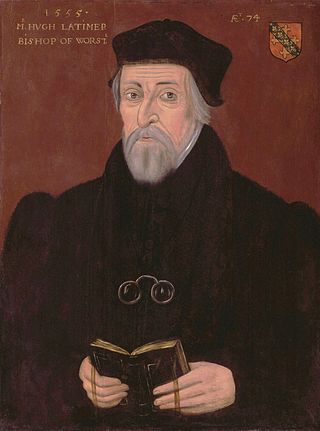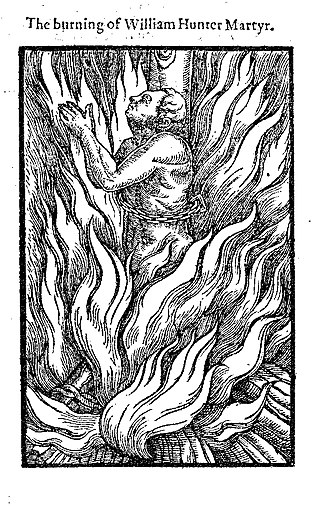Related Research Articles

Edmund Bonner was Bishop of London from 1539 to 1549 and again from 1553 to 1559. Initially an instrumental figure in the schism of Henry VIII from Rome, he was antagonised by the Protestant reforms introduced by 1st Duke of Somerset, Edward Seymour and reconciled himself to Catholicism. He became notorious as "Bloody Bonner" for his role in the persecution of heretics under the Catholic government of Mary I of England, and ended his life as a prisoner under Queen Elizabeth I.

Hugh Latimer was a Fellow of Clare College, Cambridge, and Bishop of Worcester during the Reformation, and later Church of England chaplain to King Edward VI. In 1555 under the Catholic Queen Mary I he was burned at the stake, becoming one of the three Oxford Martyrs of Anglicanism.
Lawrence Saunders was an English Protestant martyr whose story is recorded in Foxe's Book of Martyrs.

William Hunter was a Marian martyr burnt to death in Brentwood, England at the age of 19 on 26 March 1555, on Ingrave Road. He had lost his job in London as a silk-weaver because he refused to attend the Catholic mass, despite an order that everyone in the City of London had to attend, and had come to live with his parents in Brentwood, but got into a dispute when discovered reading the Bible for himself in Brentwood Chapel. He refused to accept the Catholic dogma of transubstantiation according to which the bread and wine of the communion become the body and blood of Jesus.

Rowland Taylor was an English Protestant martyr during the Marian Persecutions.
The Ipswich Martyrs were nine people burnt at the stake for their Lollard or Protestant beliefs around 1515-1558. The executions were mainly carried out in the centre of Ipswich, Suffolk on The Cornhill, the square in front of Ipswich Town Hall. At that time the remains of the medieval church of St Mildred were used for the town's Moot Hall. Later, in 1645 Widow Lakeland was executed on the same site on the orders of Matthew Hopkins, the notorious Witchfinder General.

The Oxford Martyrs were Protestants tried for heresy in 1555 and burnt at the stake in Oxford, England, for their religious beliefs and teachings, during the Marian persecution in England.
Robert Glover was an English Protestant martyr who was burnt at Coventry in September 1555.
Robert or Robbie Glover may refer to:
Joan Waste or Wast was a blind woman who was burned in Derby for refusing to renounce her Protestant faith.

Richard Woodman was a Protestant martyr, who was born in Buxted and lived in nearby Warbleton in East Sussex. He was burnt during the Marian Persecutions in 1557 in Lewes. The cult of the Sussex Martyrs is said to have been started using an etching by James Henry Hurdis of Woodman burning as a Protestant martyr.

The Coventry Martyrs were a disparate group of Lollard Christians executed for their beliefs in Coventry between 1512 and 1522 and in 1555. Eleven of them are commemorated by a six-metre-high (20 ft) monument, erected in 1910 in a public garden in the city, between Little Park Street and Mile Lane; and by a mosaic constructed in 1953 inside the entrance to Broadgate House in the city centre. Some of the streets in the city's Cheylesmore suburb are named after them.

Thomas Hawkes was an English protestant martyr who burned to death in 1555 during the Marian Persecutions rather than allow his son to be baptised into the Roman Catholic Church.
The Canterbury Martyrs were 16th-century English Protestant martyrs. They were executed for heresy in Canterbury, Kent, and were the last Protestants burnt during the reign of Mary I. Their story is recorded in Foxe's Book of Martyrs.
William Flower was a 16th-century English Protestant martyr. His story is recorded in Foxe's Book of Martyrs. He was burnt to death on 24 April 1555 at St. Margaret's churchyard, Westminster, London.
Bartholomew or Bartlet Green, was an English Protestant.
Anne Hooper or Anne de Tscerlas was a Flemish Protestant activist. She became one of the first wives of an English bishop when her husband became the Anglican Bishop of Gloucester and Worcester. She corresponded with other activists and died of the plague in the same year as her husband, John Hooper became a Protestant martyr.

The Stratford Martyrs Memorial is a memorial that commemorates the group of 11 men and two women who were burned at the stake together for their Protestant beliefs, at Stratford-le-Bow or Stratford near London in England on 27 June 1556, during the Marian persecutions.
References
- ↑ Foxe's Book of Martyrs: 313. Cornelius Bungey Exclassics.com. Retrieved on 2014-11-07.
- ↑ Munden, Alan (1997) The Coventry Martyrs (Coventry: a Coventry Archives publication).